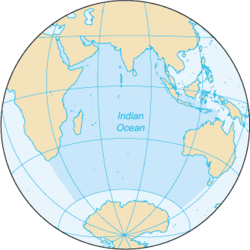 Pinguin in the Indian Ocean in 1941. | |
| History | |
|---|---|
| Name | Kandelfels |
| Owner | DDG Hansa |
| Builder | Deutsche Schiff-und Maschinebau A.G. Werk A.G. 'Weser' (Deschimag) |
| Launched | 12 November 1936 |
| Completed | 1937 |
| Renamed | Schiff 33/HSK-5 |
| Fate | Requisitioned by Kriegsmarine , 1939 |
| Name | Pinguin |
| Namesake | Penguin |
| Builder | Deschimag A.G. Weser, Bremen |
| Yard number | 5 |
| Acquired | 1939 |
| Recommissioned | 6 February 1940 |
| Reclassified | Auxiliary cruiser, 1940 |
| Nickname(s) |
|
| Fate | Sunk in the Indian Ocean by HMS Cornwall, 8 May 1941 |
| General characteristics | |
| Type |
|
| Displacement | 17,600 long tons (17,900 t) |
| Length | 155 m (509 ft) |
| Beam | 18.7 m (61 ft) |
| Draft | 8.7 m (29 ft) |
| Installed power | 7,600 hp (5,700 kW) |
| Propulsion | 2 × 6-cylinder diesel engines |
| Speed | 17 knots (31 km/h; 20 mph) |
| Range | 60,000 nmi (110,000 km; 69,000 mi) at 12 kn (22 km/h; 14 mph) |
| Endurance | 207 days |
| Complement | 401 |
| Armament |
|
| Aircraft carried |
|
Pinguin was a German auxiliary cruiser (Hilfskreuzer) which served as a commerce raider in the Second World War. The Pinguin was known to the Kriegsmarine as Schiff 33, and designated HSK 5. The most successful commerce raider of the war, she was known to the British Royal Navy as Raider F. The name Pinguin means penguin in German.

